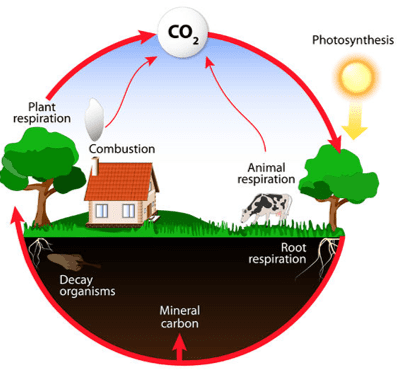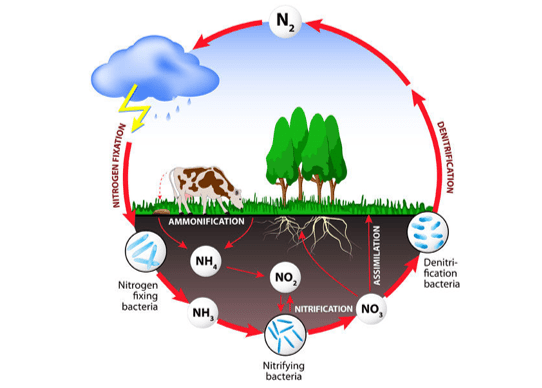In this post
The carbon cycle
Carbon is an element which is essential for life. It is usually found in the form of carbon compounds inside living organisms. There is only a fixed amount of carbon in the world, but it is constantly being recycled between different forms in the cycle known as the carbon cycle.
The carbon cycle has several stages including respiration, decomposition and combustion which release carbon in the form of carbon dioxide into the atmosphere, and photosynthesis which takes in carbon dioxide and converts it into other carbon compounds. The carbon cycle can be seen in the following diagram:

- Respiration – respiration is a process used by living organisms where the organism takes in oxygen and combines this with glucose to make energy. Water and carbon dioxide are produced as waste products. The carbon dioxide is then released into the atmosphere where it is available for the next stage of the cycle – photosynthesis.
- Photosynthesis – in photosynthesis green plants take in carbon dioxide from the atmosphere and combine it with water, using the energy from the Sun, to produce glucose and oxygen. The green plants also use the carbon in the carbon dioxide to produce other carbon compounds such as carbohydrates, fats and proteins.
These carbon compounds are then passed on to the primary consumers when they eat and digest the green plants. - Decomposition – when the green plants and animals die, the carbon compounds contained in their bodies will still be present. The remains of these plants and animals will be broken down by microorganisms such as bacteria or fungi. This breaking down is known as decomposition. As the microorganisms are breaking down the dead organic matter they release carbon dioxide into the atmosphere because of respiration. This carbon dioxide can then be taken in by more green plants during photosynthesis.
- Combustion – fuels such as wood, gas, coal and oil contain carbon compounds. When these fuels are burned in the presence of oxygen, carbon dioxide is produced and released back into the atmosphere.
If humans continue to burn fossil fuels, the amount of carbon dioxide in the atmosphere will rise beyond a level where it can easily be recycled by photosynthesis.
This results in an increasing accumulation of carbon dioxide in the atmosphere which contributes to enhanced global warming. The effects and implications of this will be explored later in the topic.
The nitrogen cycle
Nitrogen is one of the main elements needed to make proteins which are needed for growth in plants and animals. Nitrogen gas (N2) makes up 78% of the Earth’s atmosphere. However, in its gaseous form, N2 is very unreactive and cannot be easily broken down, so is not useful to plants or animals.
The nitrogen gas must be converted into nitrogen compounds such as nitrates which can be taken in by plants from the soil. The plants then use the nitrogen in the nitrates to produce proteins which can be passed along the food chain from producers to consumers. Once the plants and animals die, their rotting remains contain protein which must be broken down to produce nitrogen which can then be returned to the atmosphere for the whole cycle to start again. This recycling of nitrogen is known as the nitrogen cycle and is shown in the following diagram:

The nitrogen cycle occurs over several stages involving four different types of bacteria. The roles of these bacteria and the stages of the nitrogen cycle are described as follows:
- Nitrogen fixation – in this stage of the nitrogen cycle the nitrogen gas from the atmosphere is converted into nitrates in the soil. This can occur:
- Naturally through the effects of lightning where the nitrogen gas reacts with oxygen gas to produce nitrates which enter the soil.
- By nitrogen-fixing bacteria found in the roots of a plant or in the soil.
Some nitrogen-fixing bacteria are found in nodules on the roots of legume plants such as beans and peas. These bacteria convert the nitrogen into nitrogen compounds which can leak into the soil during plant growth or which are released into the soil when the plant decomposes. - Other types of nitrogen-fixing bacteria are found in the soil. These bacteria convert the gaseous nitrogen into the nitrogen-containing compound ammonia, and then ammonium ions which are stored in the soil.
- Decomposition – the waste material produced and excreted by consumers in the form of urine and faeces contains protein and urea. Decomposers are bacteria which break down the protein and urea and convert them into ammonia. The ammonia then forms ammonium ions in the soil which are used in the next stage of the cycle.
- Nitrification – this stage of the nitrogen cycle involves nitrifying bacteria. These bacteria convert the ammonia and ammonium ions in the soil into nitrites. Another type of nitrifying bacteria then converts the nitrites into nitrates which can be absorbed into plants from the soil by their roots.
- Denitrification – in this stage of the nitrogen cycle the denitrifying bacteria convert the nitrates in the soil back into nitrogen gas which is returned to the atmosphere for the cycle to start all over again.



